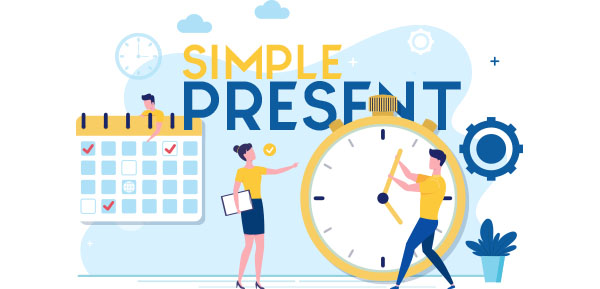What is the Simple Present:
The simple present tense ,or (present simple), is a common tense in English, and common to new learners. It is used specifically with verbs like “to be” or “to have.” It is important to know when to use it and how to conjugate it. You will need the simple present mostly to talk about daily life activities.
When to Use:
Using simple Present tense with examples:
For activities that happen regularly in the present:
- I feed my cat before leaving the house
- The airplane to Paris leaves every two hours.
- Anna drives to work at 9am.
When talking about facts:
- There are 7 days in a week.
- The sun rises in the East.
- Ice melts at high temperature.
For habits:
- Jamal goes to the gym every weekend.
- I eat lunch each day at 1pm.
- She reads a book every night.
How to Use:
Conjugating verbs in the present tense follows a regular pattern (that is, forms), which must be memorized. Here are the rules to understand:
Most regular verbs:
The third-person singular (he/she/it) is formed by adding an “s” at the end:
- I,you,we,you,they = drive
- He, she, it = drives
Exception Verbs
1. For verbs that end with (ss, sh, ch, th, x, z), or o, you add “es” at the end:
The verb to pass:
- I,you,we,you,they= pass
- He, she, it = passes
The verb to smash:
- I,you,we,you,they = smash
- He, she, it = smashes
The verb to touch:
- I,you,we,you,they = touch
- He, she, it = touches
The verb to bathe:
- I,you,we,you,they= bathe
- He, she, it = bathes
The verb to fix:
- I,you,we,you,they = fix
- He, she, it = fixes
The verb to buzz:
- I,you,we,you,they = buzz
- He, she, it = buzzes
The verb to go:
- I,you,we,you,they = go
- He, she, it = goes
2- Verbs that end in consonant + y, delete y and add ies:
The verb to try:
- I,you,we,you,they = try
- He, she, it = tries
The verb to study:
- I,you,we,you,they = study
- He, she, it = studies
Conjugation of “To Have” and “To Go”
The verb to have can be defined as the manner of showing possession or a quality.
To go is a verb that is related to movement (that is, travel) in a specific direction.
| Subject | To Have | The Rest of the sentence |
|---|---|---|
| I / you / we / they | have | a book. |
| he / she / it | has | a new house. |
Negative form
Read these negative sentences:
- I like basketball but I don’t like tennis. (don’t = do not)
- I don’t live in Paris now.
- I don’t know how to dance but I play the guitar.
- Zed doesn’t live in Italy. (doesn’t = does not)

